#Introduction
In the spring of 2013, everyone was talking about Massive Open Online Courses (MOOCs). Startup companies like Coursera and Udacity were offering free courses from distinguished professors. MIT and Harvard joined forces to create EdX. Everyone was promising a revolution in education, in which high-quality learning experiences would be available to anyone with a computer and Internet connection, anywhere in the world, from Boston to Bogota to Bangalore.
We were skeptical. We certainly recognized that MOOCs could play a role in the educational ecosystem. Watching a video lecture by a university professor can be an interesting and rewarding experience. But we doubted whether MOOCs, at least in their current form, could support the types of learning experiences that we felt were most valuable. We worried that MOOCs were focusing too much on delivering content to students – and not enough on engaging students in creative and collaborative learning experiences.
Instead of simply complaining about MOOCs, we decided to create our own. Our goal was to create an online course more aligned with our own educational sensibilities and style. We were not opposed to “massive” but it was not our first priority. Could we bring our interest-driven, project-based, peer-oriented learning approach to the world of MOOCs?
In developing the course, we brought together expertise and experience from two different organizations. Mitch and Natalie are researchers in the Lifelong Kindergarten group at the MIT Media Lab, where they develop new technologies and activities to engage children in creative learning experiences. Philipp is co-founder of Peer-to-Peer University (P2PU), a grassroots open-education project that designs and organizes online learning experiences, with special focus on people learning with and from one another.
When Philipp came to the Media Lab in 2012 as a visiting fellow, the three of us decided to join forces to experiment with MOOCs. In particular, we decided to create an online version of a course called Technologies for Creative Learning, which Mitch had been teaching at MIT over the past decade. The course had been organized as a project-based seminar. Throughout the semester, students worked together in small groups, designing technologies and activities to engage people in creative learning experiences. During the weekly meeting of the class, students discussed readings and provided feedback on one another’s projects. The course typically attracted about 25 graduate students each year, mostly from the MIT Media Lab and the Harvard Graduate School of Education.
For the spring 2013 semester, we decided to open up the course so that people around the world could participate online for free (with no credit or certification), in parallel with the in-person course at MIT (where students were receiving academic credit). Our goal was to engage more people in exploring and discussing ideas related to creative learning, so we renamed the course “Learning Creative Learning.” In a recursive twist, we wanted the course itself to be a model of creative learning, so that course participants would be experiencing the creative-learning process at the same time that they were learning about it.
At first, Natalie expressed hesitation about whether the online experience would work well, and if we could preserve the hands-on character of the Media Lab course in the online environment, but she agreed to join the design and planning. Philipp worked with the P2PU team to create a playful and inviting website which clearly stated that the course was “a big experiment.” We sent out some tweets and emails about the course, but had no idea what type of response to expect. Word about the course spread rapidly, as the announcement was picked up by a few prominent blogs and websites. Within a week, about 25,000 people had registered to participate. In the end, about 10,000 people joined the discussion forum for the course, and a few thousand people actively contributed.
We were happy that so many people were interested, and particularly pleased at the diversity of the participants – including not only educators (which we expected), but also parents, librarians, designers, lawyers, and technologists from around the world. At the same time, we were worried. Could we provide a meaningful learning experience to such a large group of people?
#A Big Experiment
Right from the outset, our mantra was: This is an experiment, and we invite everyone to experiment with us. This approach was consistent with ideas highlighted in the course itself. One underlying theme throughout the course is the importance of iterative experimentation, or tinkering, in the learning process. So it was natural for us to explore the possibilities of MOOCs by experimenting and tinkering.
By framing the course as a prototype, rather than a final product, we were able to manage our own expectations as well as those of the participants. Anxieties around how to facilitate or interact with so many people gave way to cautiously optimistic excitement when many of the participants told us that the experimental aspect was their favorite part of the experience.
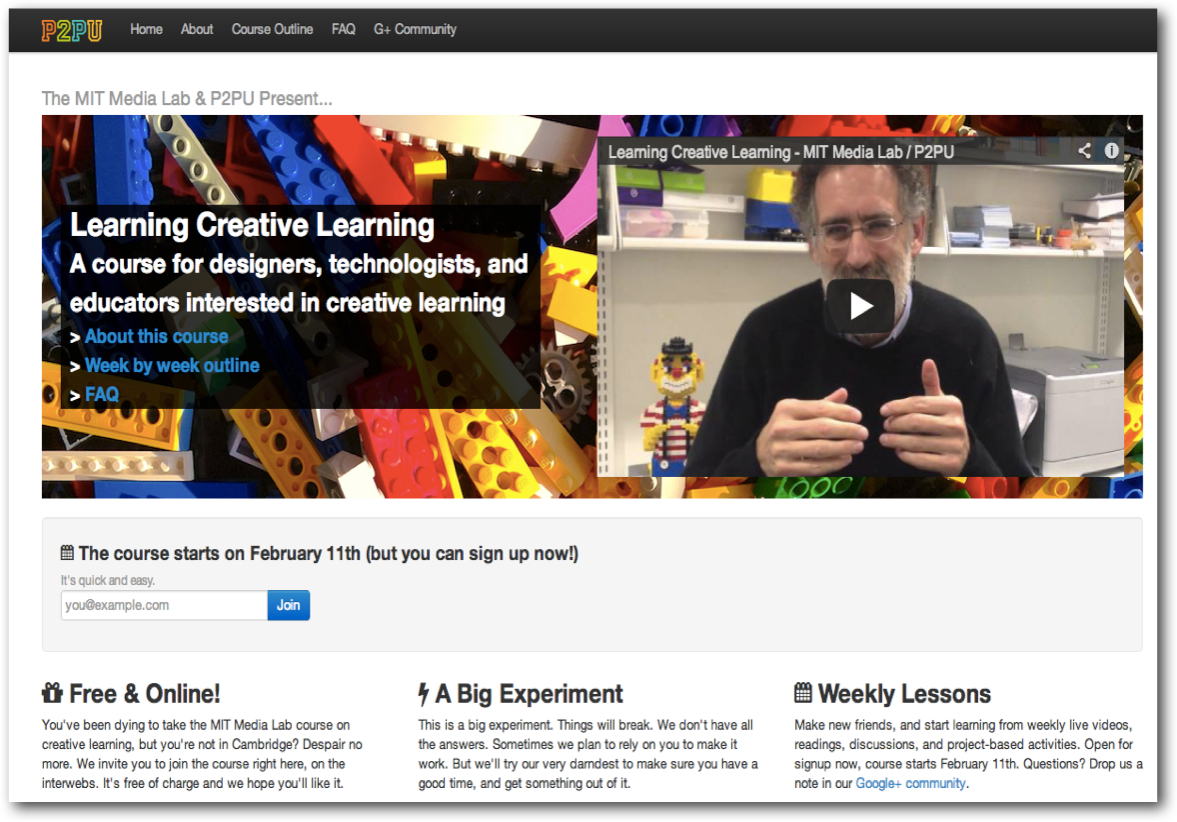
Framing the course as an experiment did not mean that we skipped on careful planning and preparation. We had long conversations to tease out the challenges of opening up a Media Lab course. And some of the things that Philipp in particular felt excited about – like how to enable lots of people to participate, or how to provide lots of freedom to the learners themselves – also helped us identify which aspects of the course we wanted keep more control of. We didn’t just want to throw the doors open to see what would happen. Letting people know right from the outset that we didn’t have all the answers meant that whenever technical hitches came up, as they invariably did, participants responded to each other by saying “Remember, they said from the start that this was a prototype,” which allowed the community to have a sense of ownership over the experiment, including its successes and its failures.
#Course Design and Technology
When designing the course structure, we emphasized learning through projects and learning with peers – in part because those learning approaches were central to the traditional in-person version of the course at the Media Lab, but also because those approaches tend to be under-represented (and under-valued) in large online courses.
We constantly explored ways of making the course more participatory. Each week we introduced a learning activity, such as “create a Scratch project and share it with others” or “explore a physical learning venue in your community”. Learners actively experienced different aspects of creative learning, rather than being asked to read about them. We also encouraged participants to give feedback to each other and collaborate on projects.
In another departure from the typical MOOC model, we decided to host a weekly live event, with video streamed from a lecture room at MIT. Online participants could not only “watch” the seminar, but also participate in a back-channel chat system we had developed (as an open-source platform). We tried to connect the discussions in the classroom with those of the online community, but this proved to be challenging. We also learned that doing something “live” can be stressful, because so much can (and will) go wrong with technology, and it can be distracting for the speaker to navigate the local and the virtual audiences at the same time.
Our platform was the web. While many MOOC projects spend a great deal of time and money developing new platforms, we decided to take a different approach. We wanted to create a model that is easy for anyone to replicate, so we used off-the-shelf tools, like Google Hangouts and open-source software like the Mechanical MOOC, which manages sign-ups and makes it easy to automate weekly course emails. Our goal was to show that it is not that hard to build a course like this, and that you do not need a lot of money to do it.
For the live seminars, we used Google Hangouts on Air, which provides streaming and archiving. We chose Google+ communities as the core platform for discussions and sharing, because of the large number of participants (at one point, our Learning Creative Learning community was one of the 100 largest G+ communities) and because G+ communities integrates well with G+ Hangouts.
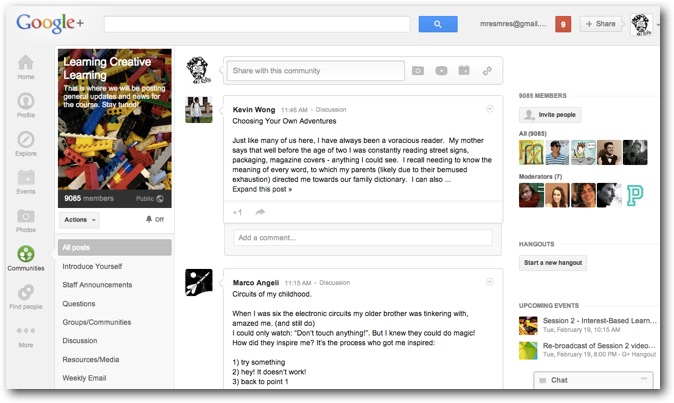
We also experimented with ways to form smaller groups. Large community spaces are great to feel a sense of activity and excitement, to get fast replies (because someone is always online), and to get a broad diversity of opinions and ideas. But it is also easy to feel lost in the crowd. Working in smaller groups makes it easier to develop deep relationships with other learners, feel invested in each other’s work, and provide ongoing support and encouragement. We automatically created email lists of 40 people, based on time zones. We also encouraged participants to start their own groups. We were excited to see more than 450 groups form, some based around location, others based around interests. It is fair to say that the automatic grouping did not work as well as we had hoped. Most email groups floundered after initial excitement and a flurry of introduction emails. We identified several reasons for this: participants often received more immediate feedback in the larger G+ forum than in the subgroup; members within the subgroup often did not find common interests and preferred to communicate with other participants in the community; and we did not make a strong effort to tie group collaboration into the activities of the course. Our survey results confirmed that most participants felt their groups did not work. At the same time, almost everyone who filled out the survey encouraged us to try again and get better at grouping – because they saw the potential of small groups for knowledge sharing, networking, and support. One group that did thrive developed a group identity, initiated intercontinental collaborations, and took leadership roles in the course the following year.
#Collaborators over Recipients
From the beginning, we hoped to engage students in the design of the course itself. Rather than designing the course to provide a uniform experience for every student, we designed structures in which the participants could participate in different ways, using the tools they are comfortable with. And we encouraged participants to share tools and activities with one another: we were interested to see what new practices would emerge if we invited thousands of co-learners to experiment with us.
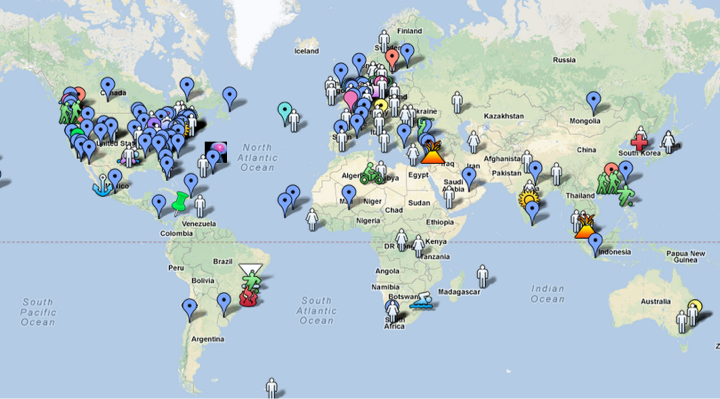
During the first days of the course, a participant from Italy posted that he would like to see a global map of all the people who had joined. We were excited about that idea and enthusiastically agreed and suggested he create one. And so Adriano Parraciani became the creator and steward of a map of participants. He answered technical questions and helped others add their pins to the map. And there were many other examples of participants becoming collaborators: Julie Donders and Corinne Thomson created beautiful illustrations to summarize what we discussed in our live seminars, and Simon Fogg created PDF files to combine each week’s articles into a format that was easier to download to ebook readers.
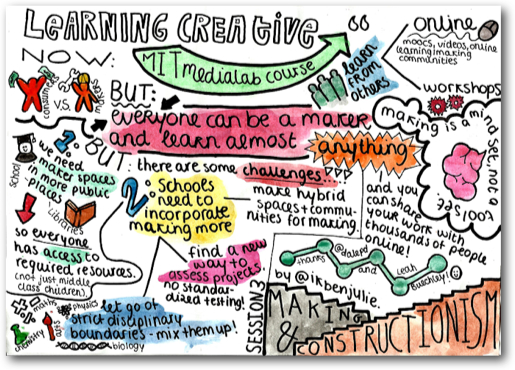
We considered the participants as our collaborators, rather than recipients of content we had created, because it signaled that they had ownership and agency. There was also a second more pragmatic reason. It is very difficult to scale meaningful learning and we needed the participants to take initiative and support each other, rather than wait for the “experts” to provide feedback and instruction. In small classrooms, we can facilitate the conversations and spend time with each student individually. At scale, that is simply not possible.
At a certain point, we realized that there was no way we could be the facilitators for that many people. Rather than telling groups which tools to use, or suggesting how to assign moderators, we let things emerge. We had to let go at a certain point to really understand what peer-to-peer learning was. Our own role changed and became more focused on highlighting and supporting the people who were adding tools and expanding the way the course worked.
#Conversations over Presentations
Too often, people think about education in terms of “delivery” or “transmission” of information. Many MOOCs are based on this metaphor, focusing on presentations of information, usually in the form of video-based lectures from academic experts. In developing Learning Creative Learning, we were determined to avoid this presentation-based approach. Our goal was to focus on conversations over presentations.
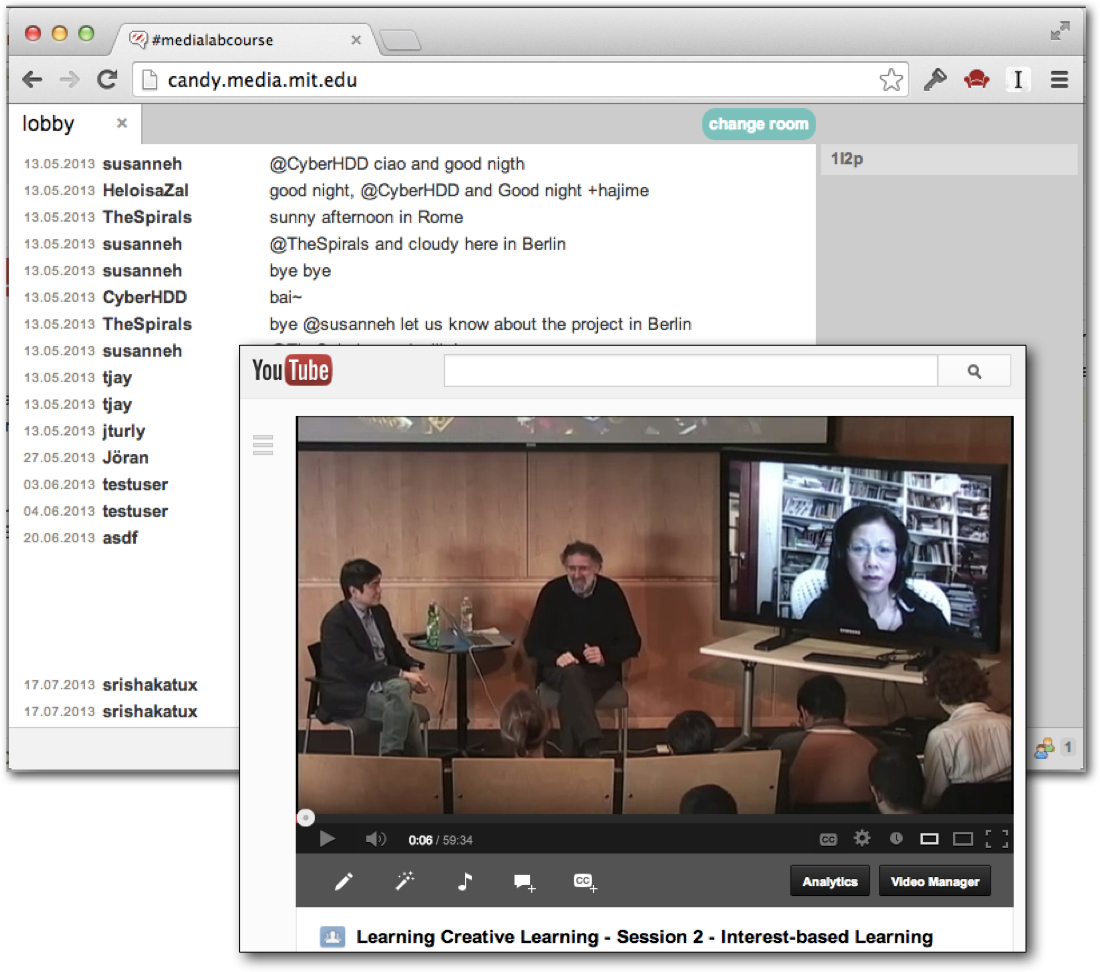
These conversations took on several different forms. In each of our weekly sessions, we organized a conversation on issues related to the theme-of-the-week. When the theme was “Interest-Based Learning”, for example, Mitch moderated a conversation with the brother-sister duo of Joi Ito (director of the Media Lab) and Mimi Ito (cultural anthropologist at University of California at Irvine), asking them to reflect on their own learning trajectories – and how their experiences had been guided by their interests and passions. When the theme was “Constructionism and Making”, Mitch moderated a conversation with Dale Dougherty (publisher and editor of MAKE magazine) and Leah Buechley (a pioneer in e-textiles design and research), sparking a discussion about the relationship between making and learning.
But these conversations were not necessarily the most important conversations taking place. We arranged a “backchannel” that enabled participants in the course to chat with one another during the webcast conversation. We were delighted by the level of activity and engagement in the back channel – and, clearly, so were the participants. As one participant wrote in the G+ discussion forum: “I think I enjoy the chat more than listening to the talk.” And another participant wrote: “I’ll have to watch the video again. I was so intrigued by the backchannel I paid more attention to this conversation.” As facilitators, we often regretted that we weren’t able to pay more attention to (and participate in) the backchannel conversation, since we were busy talking with the invited experts.
#Projects over Problem Sets
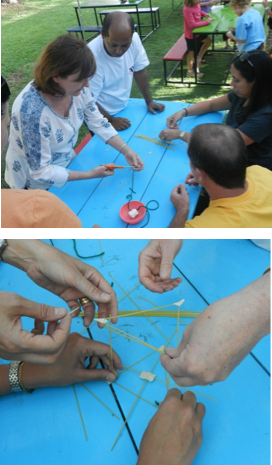
A key aspect of the Media Lab learning philosophy is that people learn best when working on projects that they find personally meaningful. In our Lifelong Kindergarten research group, we often offer face-to-face workshops in which educators or youth collaboratively create interactive stories, robotic inventions, or a wide range of other design projects. Rather than presenting them with problems to solve, we encourage them to create projects related to their interests – and, in the process, they learn to solve problems that arise in a context they find personally relevant.
For us, one of the big challenges in developing an online course was figuring out ways to support project-based activities with so many participants scattered in remote locations. For the first week of the course, we suggested an introductory design activity for small groups to build a structure out of spaghetti, with a marshmallow on top (based on the Marshmallow Challenge). We were not sure if participants online would make the effort to organize the materials and groups locally. So we were thrilled when participants in the course began sharing photos and stories of their own experiences with the activity. The discussion forum was filled with images of spaghetti-marshmallow structures from Spain, Ethiopia, and elsewhere around the world.

We made sure to engage participants in questions that could immediately establish personally meaningful connections, such as asking them, “What is an object from your childhood that interested and influenced you?” Participants from around the world shared rich descriptions, photos, and drawings of meaningful objects from their childhood. For example, Jeff Rudell described how he had carefully crafted a toy typewriter out an egg carton when he was a boy, reflecting an early interest that he continues in his career as a designer today. Seeing the connections participants around the world made as they shared reflections on their childhood experiences was the turning point that convinced Natalie of the potential of the online course to support new possibilities for creative learning.
Because participants could apply the questions and activities to their own lives – and immediately share the results – the community was dynamic and active. Whenever you checked the Google+ site, you could see new pictures that had been uploaded, with participants sharing experiences, such as, “I went out and tried this activity with people in my neighborhood, and here’s what we created.” At the beginning of each of the video sessions, we highlighted examples of what online participants had been sharing the previous week. The sharing of examples from participants became a favorite aspect of the live sessions.
#Community over Course
What started as an online course, slowly evolved into a community. It would be easy to say now that this was our intention from the start, but the truth is, we were a little surprised ourselves – surprised and excited. The online course became a springboard for learning with family, friends, and colleagues.
At one point, the whole idea of “us” (the supposed experts) teaching “them” went out of the window. Not only did the participants learn a lot from each other, we learned from participants too. For example, during the week on “Learning in Communities,” participants went out to visit physical learning spaces and reported back on what they found. We enjoyed reading about all the interesting places and models for learning from all over the world. Heloisa Zal, a participant from Brazil, described how youth are revitalizing the use of public spaces by organizing open learning, social, cultural, and political events. Graciela Arizmendi organized an open creative learning day for children and families in her town in Mexico.
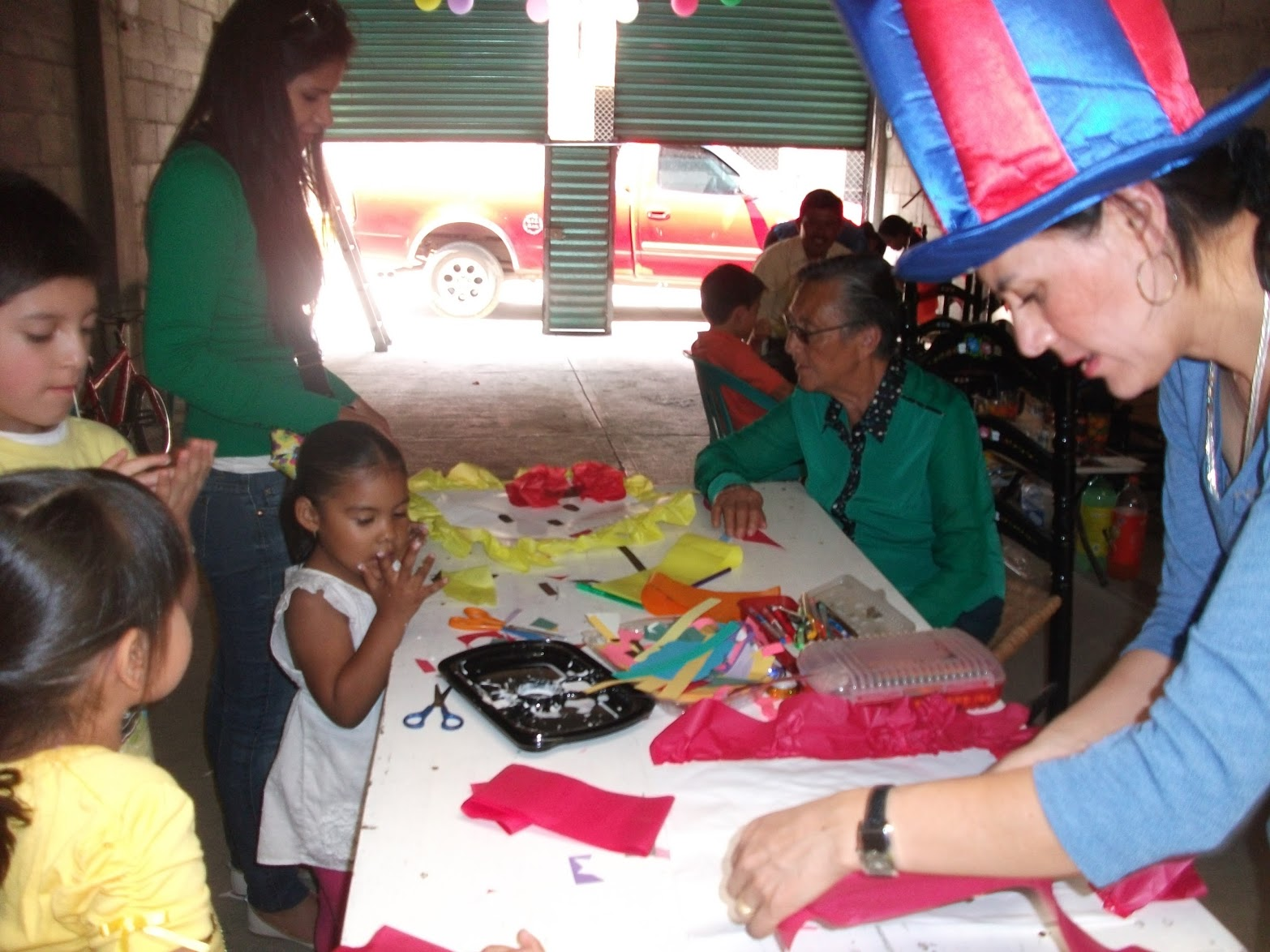
Another activity asked participants to develop a computer program in the Scratch programming environment. One participant, Cecilia Trevino, turned to her daughter when she needed help: “I found this activity challenging and I asked help from my daughter.” Parents learned from their children and together they were able to create and share projects with the online community.
The difference between a typical online course and a learning community was felt particularly strongly during the week after the Boston Marathon Bombings. MIT was locked down for a few hours, nobody was allowed to leave the Media Lab building, and anxiety levels in the city and on campus were high. We felt overwhelmed by the supportive messages that poured in from the online community, from people all around the world. Learning Creative Learning had evolved from a course to a community of people who took an interest, not only in one another’s learning, but in one another’s lives.
After the course officially ended, the community continued, defying the standard MOOC model. At education conferences throughout the year, Learning Creative Learning participants have been meeting up face-to-face, to extend and deepen the relationships that started online. After almost every presentation that we give these days, someone will come up afterwards and tell us that they took the course. After speaking at a conference in Berlin, Philipp learned about a group of eight local participants who had never met before the course but were still in touch with each other months after the course had ended. Mitch even got interrupted in the gym once, by someone who placed a piece of paper on top of the treadmill while Mitch was exercising. The paper said simply: “Thank you for Learning Creative Learning.”
#The Future of Creative Learning Online
Offering Learning Creative Learning as an online course for thousands of participants took a lot of effort. When the course ended, we all felt we needed a break. But during the next few months we kept reflecting on the experience and thinking of changes we would make if we ran it again. Then, in spring 2014 we did run it again – and we continued to experiment. In the first iteration of the course, we had felt constrained by offering the online version simultaneously with the official course at MIT. So we decided to offer only the online version in spring 2014. Freed from the semester-length timetable for university courses, we made the online version shorter and experimented with other changes in the format.
We designed a number of core modules that could be taken in any order. These modules introduced four principal ideas of our creative learning framework: projects, peers, passion, and play. We also added a class project, called Reimagine Education, at the end. One of the challenges we noticed in the first iteration of the course was that educators were struggling to apply the ideas of creative learning within the rigid structures they faced within their schools. We wanted to shine the light on successful examples of how this integration could be done and encourage participants to start collaborating beyond the course.
We also kept experimenting with different formats for the weekly live event, hosting the sessions on Philipp’s new Unhangout platform, which supports embedding videos and chat as well as break-out rooms. In 2013, streaming live was exciting, but it was also stressful and introduced a lot of technical challenges that were distracting from the content. In 2014, we retained the conversational format of many of the seminars, but pre-recorded them and then “watched” them together with the course participants. This allowed us to preserve the excitement of a live event, and at the same time enabled us to participate in the backchannel discussions. We also added live breakout conversations, in which participants gathered in virtual rooms, with up to ten people per room, typically for 10-15 minutes. These breakouts received very positive feedback in the course evaluation. We were happy to see that participants still value the possibility of speaking with one another over listening to us.
In 2013, the public conversation about online learning was dominated by broadcast-oriented MOOCs, focused on streaming video lectures. Since then, we have been happy to see many examples for other formats emerge, like the Connected Learning MOOC or the Deeper Learning MOOC. Some of them were directly inspired by Learning Creative Learning, or used tools we developed; others are part of a new wave of experimentation. Between 2013 and 2014, we made many changes to the technology and the course structure, but we stuck to our core design principles and the goal to support creative learning online.
There is now a growing awareness that broadcasting short video content to larger numbers of people misses the things that are most important for learners: working on projects that they are passionate about, in collaboration with peers, within a playful environment that encourages experimentation. Learning Creative Learning was our first attempt at supporting this kind of learning online and at scale. We’ve learned a lot from the experience, but there is still much more to be learned.
#Want To Learn More?
A lot of the learning, interactions, and materials from Learning Creative Learning are online and free to use. If you want an overview of the course, to get a rough idea of what we did, take a look at the course home page (http://learn.media.mit.edu/lcl), where you can also find links to the course materials. The LCL community has since moved from G+ to a new discussion forum at http://discuss-learn.media.mit.edu. The unhangout platform (http://unhangout.media.mit.edu) allows anyone to create events or set up their own server.
###Acknowledgments
We would like to thank the Hewlett Foundation for ongoing support of work at P2PU (Grant Number: 2013-8917), the LEGO Foundation for its ongoing support of the Lifelong Kindergarten group at the MIT Media Lab, and Sanjay Sarma of the MIT Office of Digital Learning for his support for our efforts to tinker with MOOCs.
We thank the research assistants that helped develop and organize Learning Creative Learning: Saymindu Dasgupta, Katherine McConnachie, Alisha Panjwani, Grif Peterson, Ricarose Roque, Aya Sakaguchi, and Srishti Sethi.
We also thank Rebecca Kahn for conducting an initial interview with the three of us, nudging us to think of the key lessons we learned, and working on an earlier version of this report.